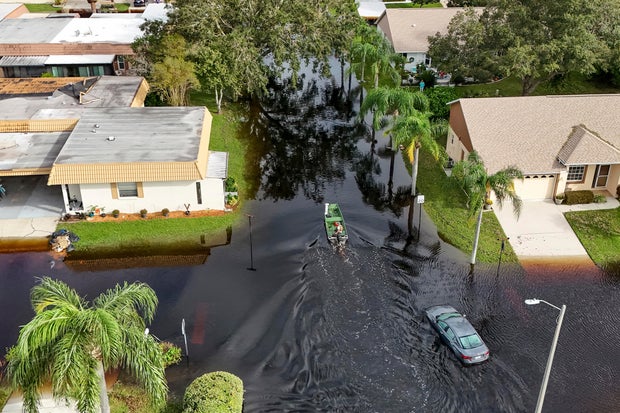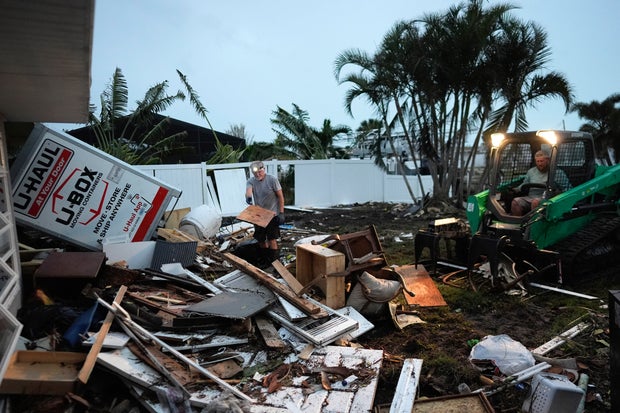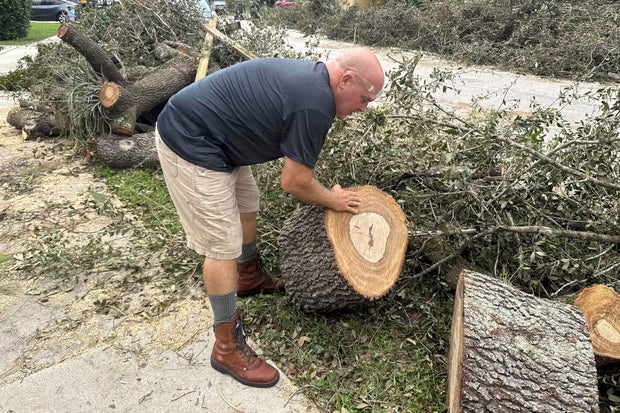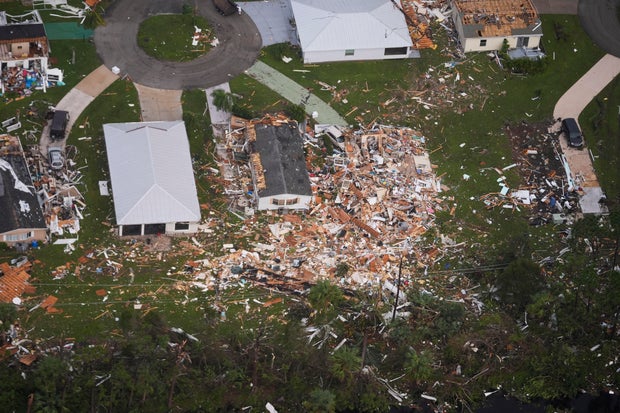
Floridians recovering from Hurricane Milton, many of whom were journeying home after fleeing hundreds of miles to escape the storm, spent much of Saturday searching for gas as a fuel shortage gripped the state.
In St. Petersburg, scores of people lined up at a station that had no gas, hoping it would arrive soon. Among them was Daniel Thornton and his 9-year-old daughter Magnolia, who arrived at the station at 7 a.m. and were still waiting four hours later.
“They told me they have gas coming but they don’t know when it’s going to be here,” he said. “I have no choice. I have to sit here all day with her until I get gas.”
Gov. Ron DeSantis told reporters Saturday morning that the state opened three fuel distribution sites and planned to open several more. Residents can get 10 gallons each, free of charge, he said.
Getty Images
“Obviously as power gets restored…and the Port of Tampa is open, you’re going to see the fuel flowing. But in the meantime, we want to give people another option,” DeSantis said.
About one in three gas stations across the state were still closed Saturday, many of which are unable to operate because they are still without power, causing a bottleneck for those that are open.
DeSantis said that 37 million gallons of gas arrived at Florida ports Saturday.
“We have Florida Highway Patrol that will escort the tankers from the ports to the respective service stations,” DeSantis said.
Chris O’Meara / AP
Tensions boiled over at one gas station north of Tampa Saturday over the long wait times.
“They were fighting, like fist fighting,” Tootie Jones, a gas station security guard, told CBS News. “One girl hit another girl with a car.”
In the community of Brandon east of Tampa, one woman said she had been waiting in line for gas for two hours.
Milton killed at least 23 people when it tore across central Florida on Wednesday, flooding barrier islands, ripping the roof off the Tampa Bay Rays’ baseball stadium and spawning deadly tornadoes.
Officials say the toll could have been worse if not for the widespread evacuations. Overall, more than a thousand people had been rescued in the wake of the storm as of Saturday, DeSantis said.
AP Photo/Mike Carlson
The still-fresh devastation wrought by Hurricane Helene just two weeks earlier probably helped compel many people to flee.
“Helene likely provided a stark reminder of how vulnerable certain areas are to storms, particularly coastal regions,” said Craig Fugate, who served as administrator for the Federal Emergency Management Agency under President Barack Obama. “When people see firsthand what can happen, especially in neighboring areas, it can drive behavior change in future storms.”
More than 1.2 million customers in Florida remained without power Saturday evening, according to Find Energy. The White House said 50,000 workers, many from across the U.S. are working to restore power.
CBS News traveled Saturday the hard-hit community of Valrico east of Tampa, where floodwaters swallowed up entire neighborhoods.
Terry Rudd and his family are just now returning to see what’s left of their home.
“This is going to be a mess here to try to rebuild,” Rudd said.
The Rudd family lost a car, and the floor of their home is caving in.
“We’re gonna cry, we’re gonna cry a lot after this,” family member Tiffany Nagy said. “The love we have in this family will always be there.”
AP Photo/Rebecca Blackwell
Many Florida residents, meanwhile, were grateful to be coming back alive.
“I love my house, but I’m not dying in it,” Fred Neuman said Friday while walking his dog outside a rest stop off Interstate 75 north of Tampa.
Neuman and his wife live in Siesta Key, where Milton made landfall Wednesday night as a powerful, Category 3 hurricane. Heeding local evacuation orders ahead of the storm, they drove nearly 500 miles to Destin on the Florida Panhandle. Neighbors told the couple the hurricane destroyed their carport and inflicted other damage but Neuman shrugged, saying their insurance should cover it.
About 30 miles north in Zephyrhills, a CBS News crew joined the Pasco County Fire Rescue team as they waded through the water to ensure everyone got out of their homes safely.
“These are all brand new homes. These were all built within the last year and a half to two years, so they obviously went a little higher on the ground for them and they’re good still but … the original homes in this neighborhood are suffering the consequences of the three hurricanes,” a rescuer told CBS News.
The golf course community has faced flooding from hurricanes Debby, Helene and Milton, leaving the already saturated ground with little room to handle even more water.
Lee and Pamela Essenburm evacuated their home in Palmetto, on the south end of Tampa Bay, fearing Milton might hit as a catastrophic Category 4 or 5 storm.
“I wasn’t going to take a chance on it,” Lee Essenbaum said. “It’s not worth it.”
On Saturday, President Biden approved a disaster declaration for the state of Florida that makes federal funding available to affected individuals in the following counties: Brevard, Charlotte, Citrus, Clay, Collier, DeSoto, Duval, Flagler, Glades, Hardee, Hendry, Hernando, Highlands, Hillsborough, Indian River, Lake, Lee, Manatee, Marion, Martin, Okeechobee, Orange, Osceola, Palm Beach, Pasco, Pinellas, Polk, Putnam, Sarasota, Seminole, St. Johns, St. Lucie, Sumter, and Volusia and the Miccosukee Tribe of Indians of Florida.
Assistance can include grants for temporary housing and home repairs, low-cost loans to cover uninsured property losses and other programs to help people and businesses recover after Milton.
“This is ridiculous. We need power out here. We need help out here,” said Mia Watson, a resident of Palm Beach Gardens.
Tornadoes wrought unexpected damage
Tony Brazzale, a diving boat captain who has lived for 10 years in his Wellington home in southeastern Florida, wasn’t worried about Hurricane Milton. The storm’s center was forecast to land on the opposite side of the peninsula and then cross the state well to the north of his family.
But on Wednesday afternoon as the hurricane began to pummel the state, he stood outside his house and watched as a tornado loomed in the sky. He took a video on his phone. The pressure dropped, and his wife said her ears were popping. It was time to go inside.
AP Photo/Stephany Matat
The twister shattered windows in the home, tore off roof shingles, ripped a tree from the ground and left branches and other debris scattered in the yard. Two days later Brazzale was wearing safety goggles and using a chainsaw as he cleaned up the damage.
“The hurricane was a nonevent for us,” he said. “Had it not been for an F-3 tornado, the entire thing would have been a nonevent for us.”
It was one of dozens of tornadoes spawned by Milton that hit South Florida far from where the storm made landfall near Sarasota. One of them killed at least six people in Spanish Lakes Country Club Village near Fort Pierce, about an hour’s drive north from Wellington.
Meteorologists believe there may have been at least 38 tornadoes associated with Milton. The National Weather Service is still reviewing preliminary reports, which could take weeks, but it issued 126 tornado warnings in the state the day the hurricane hit.
AP Photo/Gerald Herbert
When the review is complete, the storm could crack the all-time top-10 list for most tornadoes caused by a hurricane.
One of those twisters narrowly missed Tom Perusi’s home, but it easily tossed his boat.
“We went into the bathroom, our concrete bathroom and stayed there,” he told CBS News. “And with the whole shook it, just everything shook. And when we got out, I took it serious. I thought I was all ready. I was ready for everything, not a tornado.”
Gov. Ron DeSantis warned people to not let down their guard, however, citing ongoing safety threats including downed power lines and standing water that could hide dangerous objects.
“We’re now in the period where you have fatalities that are preventable,” DeSantis said Friday. “You have to make the proper decisions and know that there are hazards out there.”
Tom Hanson
contributed to this report.











